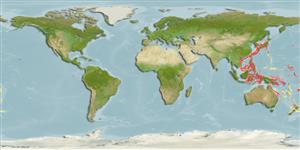>
Anguilliformes (Eels and morays) >
Congridae (Conger and garden eels) > Congrinae
Etymology: Bathycongrus: Greek, bathys = deep + Latin, conger = conger (Ref. 45335).
More on authors: Jordan & Snyder.
Environment: milieu / climate zone / depth range / distribution range
Ecologia
marino batidemersale; distribuzione batimetrica 150 - 450 m (Ref. 7446). Deep-water
Western Pacific: Japan to the Philippines.
Size / Peso / Age
Maturity: Lm ? range ? - ? cm
Max length : 54.0 cm TL maschio/sesso non determinato; (Ref. 7446)
Short description
Chiavi di identificazione | Morfologia | Morfometria
Body moderately elongate. Tail slender, attenuate at tip. Snout bluntly pointed, protruding beyond tip of lower jaw. Preserve specimen, head and body pale brown dorsally, much paler on belly. Caudal fin black, pectoral fin pale (Ref. 37528). Dorsal-fin origin slightly behind anteriormost insertion of pectoral fin to above middle of appressed fin. Preanal lateral line pores 29-32 (Ref. 36324).
Life cycle and mating behavior
Maturità | Riproduzione | Deposizione | Uova | Fecundity | Larve
Castle, P.H.J. and D.G. Smith, 1999. A reassessment of the eels of the genus Bathycongrus in the Indo-west Pacific. J. Fish Biol. 54(5):973-995. (Ref. 36324)
IUCN Red List Status (Ref. 130435: Version 2024-2)
Threat to humans
Harmless
Human uses
Strumenti
Special reports
Download XML
Fonti Internet
Estimates based on models
Preferred temperature (Ref.
123201): 1.8 - 18.5, mean 13.6 °C (based on 98 cells).
Phylogenetic diversity index (Ref.
82804): PD
50 = 0.5000 [Uniqueness, from 0.5 = low to 2.0 = high].
Bayesian length-weight: a=0.00063 (0.00029 - 0.00138), b=3.18 (3.00 - 3.36), in cm total length, based on LWR estimates for this (Sub)family-body shape (Ref.
93245).
Trophic level (Ref.
69278): 3.9 ±0.5 se; based on size and trophs of closest relatives
Resilienza (Ref.
120179): Medio, tempo minimo di raddoppiamento della popolazione 1.4 - 4.4 anni (Preliminary K or Fecundity.).
Fishing Vulnerability (Ref.
59153): Moderate vulnerability (42 of 100).
